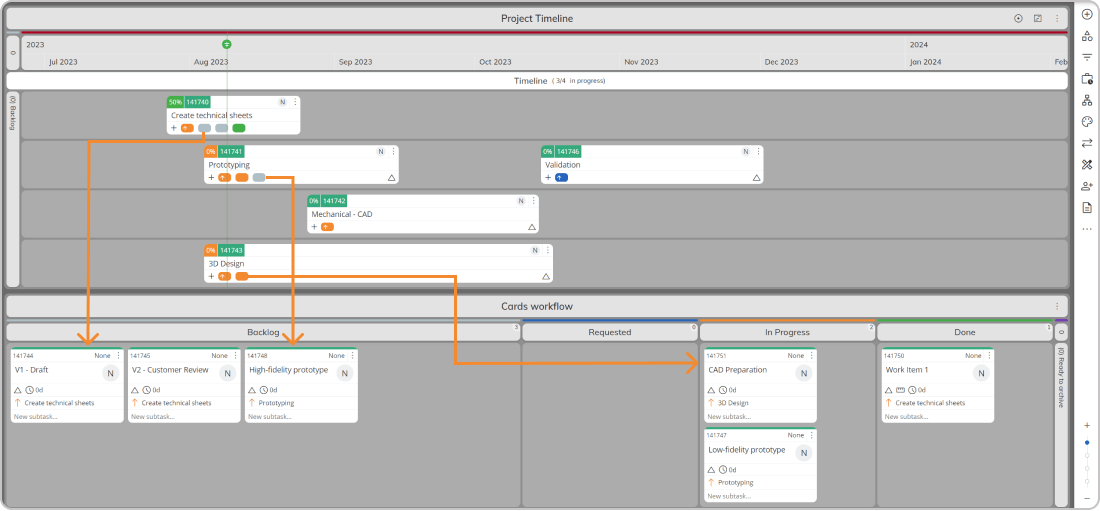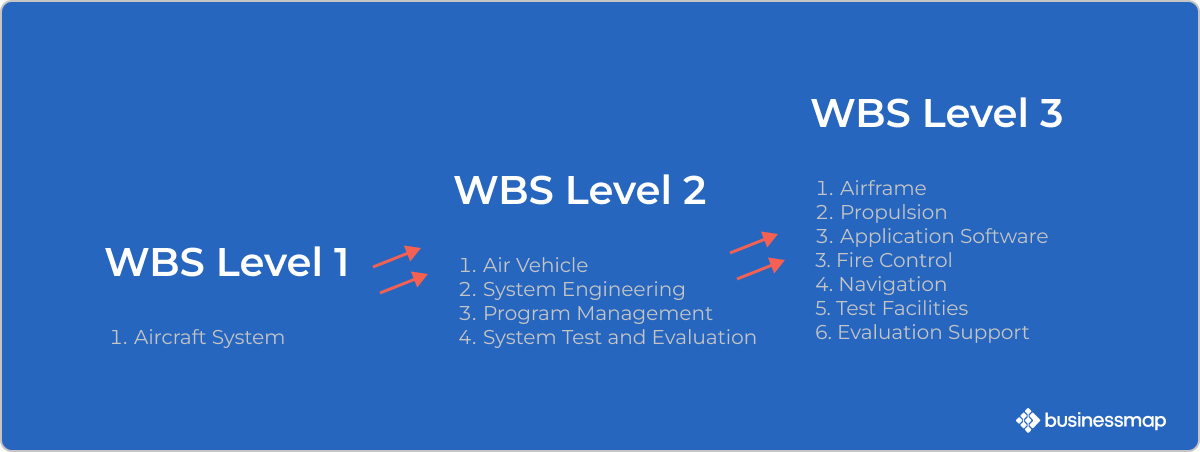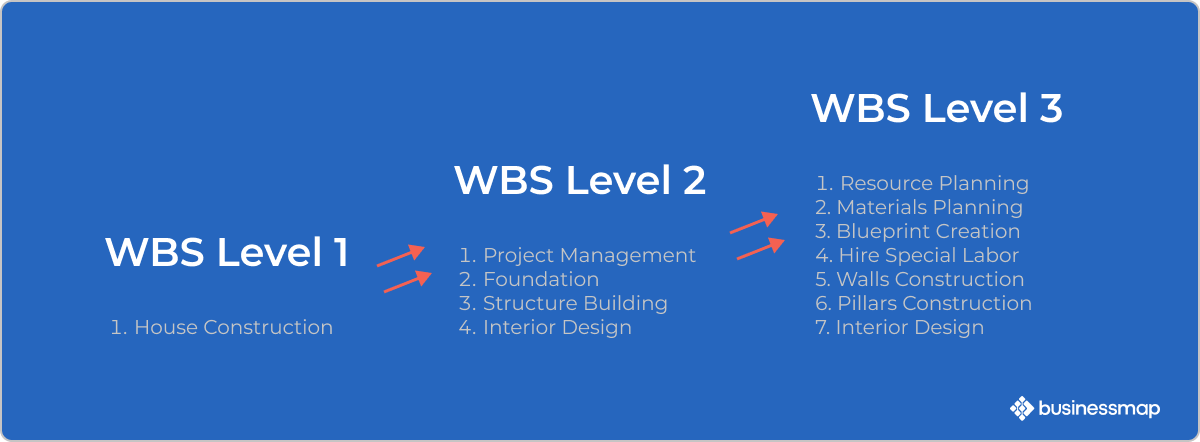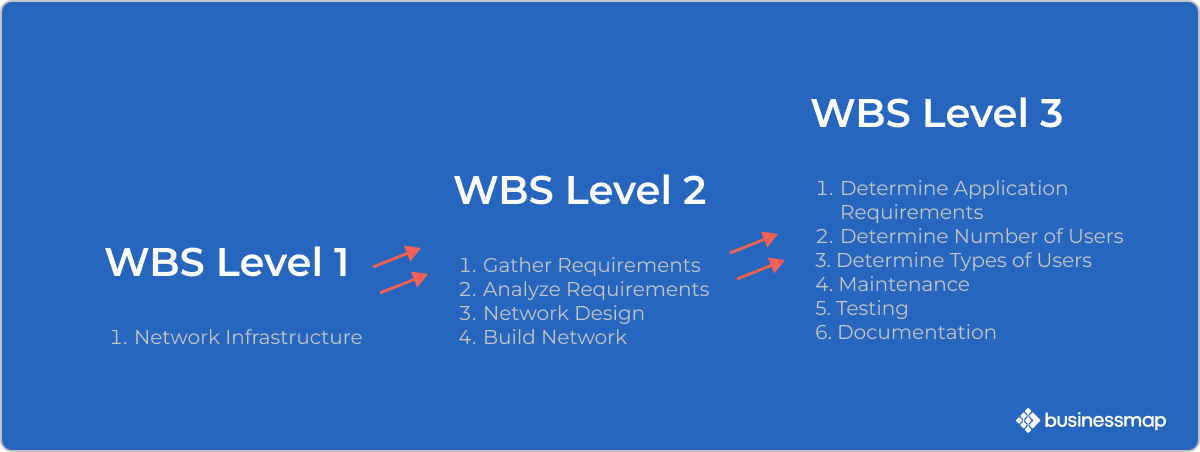The work breakdown structure (WBS) in project management is pivotal for combating scope creep and keeping projects aligned with their goals. It's not just a method for dividing tasks; it's a comprehensive practice that integrates the project's scope, schedule, and cost.
This blog will delve into the WBS, covering its definition, fundamental design principles, benefits, and practical examples. It will offer insights for more effective planning, execution, and project control. This approach sets the foundation for efficient project progress and successful outcomes.
What Is a Work Breakdown Structure?
A work breakdown structure (WBS) is a scope management process that is entirely deliverable-oriented. It is based on the order of tasks that must be completed to arrive at the final product. The WBS aims to keep all project members on task and focused on the project's purpose. It accomplishes this through a clearly and concisely written statement of work, followed by a dissection of the work required.
Nowadays, the work breakdown structure is successfully applied by creative and technical teams, teams dealing directly with clients, teams working on internal projects, or remote teams alike. The approach is also widely applicable in various industries, from construction and engineering to software development.
What Is the History Of Work Breakdown Structure?
Developed in 1957 along with the Program Evaluation and Review Technique (PERT), the approach work breakdown structure was officially described in 1962 as a collaboration between NASA, the United States Department of Defence, and the aerospace industry. Although the term was created to be used by defense organizations, the concept was introduced to non-defense sectors in 1987.
Ever since, work breakdown structures have been used in residential, commercial, and industrial construction projects. The project management process is implemented to formulate the most accurate estimate possible. It also gives the customer or investor a better idea of everything that goes into building the project to justify the estimate.
Since the rise in demand for software development across various organizations following Agile, work breakdown structures have been applied to the industry, and they've become beneficial. Whether in software development or in construction, Agile can be used to manage projects by taking a vision or idea and actually creating it based on a list of requirements.
What Is the Importance of a Work Breakdown Structure in Project Management?
A solid work breakdown structure (WBS) is a game-changer in project management, setting the foundation for success. It meticulously breaks down the project into manageable chunks, ensuring clarity, focus, and team alignment.
The WBS approach not only simplifies complex projects but also enhances resource allocation, risk identification, and progress tracking. Embracing the importance of a work breakdown structure in project management can lead to improved efficiency, reduced project risks, and a clearer path to achieving project goals, making it an indispensable tool for project managers aiming for success.
 Breaking down projects into manageable work items and visualizing the WBS on a project management board in Businessmap
Breaking down projects into manageable work items and visualizing the WBS on a project management board in Businessmap
What Are the Levels of a WBS?
A work breakdown structure is hierarchical and utilizes different levels to transform complex projects into manageable work items. While the number of levels included in a WBS analysis depends on the project's size and complexity, there are four most common work breakdown structure levels.
1. The Top Level: The Top Level defines the project's ultimate goal or final project deliverables. The project's scope should be stated using clear language, so everyone on your team understands the project's goal. For example, if you are a project manager for an aircraft system development, the top level of the WBS could be "Aircraft System Development".
2. Controls Account: The Second Level, "Control Account" maps all the project's main workflow and defines the goals to be achieved. In the definition of the controls in your WBS, you can list features, systems, or services that the customer specifically requested. For example, if you are a project manager for a software development project, an outcome could be a search functionality or a messaging tool.
3. Work Packages: The Third Level, "Work Packages" consists of groups of tasks that form the control accounts. Tasks should be manageable so project managers can coordinate their execution and monitoring. The deliverables should be defined using clear language. For instance, if your team needs to develop a database system, a task at the work packages level could be the development of a software application.
4. Activities: The Fourth Level, "Activities" defines the tasks that need to be completed to facilitate the execution of the tasks on the work packages level of the WBS. These activities are the smallest work items that contribute to a project's completion. If you are the project manager of an aircraft system development project, activities may include integrating airframe components, their assembly, or testing.
WBS Design Principles
When crafting a work breakdown structure (WBS) for project management, adherence to four key design principles ensures its efficacy and utility:
- The 100% Rule: This principle ensures the WBS includes all project work by covering 100% of the project scope, capturing every task and deliverable.
- Mutually Exclusive Elements: To avoid overlap and duplication, this principle mandates that each element in the WBS be distinct and have no shared tasks between them.
- Outcome Orientation: This focuses the WBS on deliverables rather than the processes used to achieve them, ensuring elements are defined by what they produce.
- Level of Detail: Balancing detail is crucial; the WBS should be detailed enough for effective management and control but not so granular as to become unmanageable.
These principles guide the creation of a WBS that is thorough, clear, deliverable-focused, and optimally detailed for project success.
Make a Work Breakdown Structure in 5 Steps
- Describe the Statement of Work. The statement of work is a sentence or paragraph that describes the vision and function of the project in its completed form. This portion of the WBS is the big guiding picture of the project and is generally developed by the entire project team.
- Determine Any Necessary Project Phases. Depending on the nature of the project, it may be necessary to segment the scope into multiple phases. This often depends on the time frame and budget but can also rely on the project's requirements. Some projects just make more sense in stages, such as pre and post-production.
- Develop the Deliverables of Each Phase. Outline each of the deliverables that must be completed within each phase. The deliverable should also have its own statement describing its purpose or function in the project's outcome.
- Segment Deliverables in Manageable Sections or Tasks. Describe each of the tasks required to complete each deliverable. These tasks should be designed as work packages or sections that can be easily managed by one team member or, in some cases, a small group of members.
- Assign Each Manageable Section. Assign each manageable section to the appropriate team members. These members will be responsible for the tasks involved in each section of work, ultimately leading to the corresponding deliverable. A time frame is set for each section. Its progress is tracked by whether or not the deliverable has been completed.
Benefits of a Work Breakdown Structure
WBS is a widely used method of project planning and management. Given its enormous number of benefits, it's easy to see why it has become such a popular technique for highlighting project management advantages. Below are some of the advantages of WBS, highlighting its importance.
- Project Management Efficiency. It helps to visually represent all project components: scope, stages, tasks, and deliverables required. A work breakdown structure that begins with a clear statement of work helps keep all team members focused on the end goal. In addition, it mitigates the chance that unnecessary work will be performed because the scope has been clearly defined.
- Optimized Work Allocation. When a project is broken down into manageable tasks or packages, it becomes a lot easier to assign these to the appropriate individual. This helps your team plan around other work that needs to be completed outside of the project in question.
- Improved Communication. Whether the project is performed internally or directly for clients, a work breakdown structure communicates everything from the get-go: vision, details, and assigned team members. It also maintains communication as the project progresses, which is essential in keeping everyone in the loop and tasks on track.
- Streamlined Organization of Ideas. The work breakdown structure is ideal for brainstorming and coming up with ideas of what to include in the project. Because it is such an involved planning process, it makes it easy to list all the ideas and then scratch out the unnecessary ones as the plan becomes clearer and more succinct.
- Enhanced Risk Management. It is performed before any work has begun to anticipate all project requirements. This includes resource allocation, such as time, budget, and equipment. In addition, the process of performing the work breakdown structure helps the team think about the areas of potential risk and account for them in the planning phase.
What Are the Examples of Work Breakdown Structure?
A few examples of work breakdown structures are visualized below.

Aircraft system work breakdown structure

House construction project using work breakdown structure

Network infrastructure work breakdown structure
WBS Frequently Asked Questions
What Is Included in a Work Breakdown Structure?
A work breakdown structure includes the following list of components:
- WBS Dictionary: describes in detail each element of the WBS, such as scope, tasks, deliverables, cost, etc.
- Task Number and Description: This refers to assigning a number to each task to facilitate its identification and giving a description to specify what the task is.
- Task Owner: identifies the individual or department responsible for each specific task or activity.
- Task Dependency: defines a relationship between two dependent tasks where, for instance, one task should not be started before another one is completed.
- Cost of Task: describes the estimated cost of each task contributing to the project's completion.
- Start, Finish, and Estimated Completion of Task: define the planned start and end dates of task execution.
- Task Status: refers to the current state of each task (in progress, waiting on another dependency, completed, etc.) and improves tracking.
What Are the Types of WBS?
There are three different types of work breakdown structures used in project management.
- A Process-oriented WBS: defines the project's work stages, functions, and steps to be taken to complete a project and creates a comprehensive project's scope.
- A Deliverable-oriented WBS: defines the project's deliverables, such as tangible items contributing to the overall project goal, and provides an overview of the relationship between them.
- A Time-phased WBS: defines long-term projects into major phases instead of steps, and only the approaching project phase undergoes detailed planning.
What Is the Difference Between the Work Breakdown Structure and the Gantt Chart?
The difference between a work breakdown structure and a Gantt chart stems from the goal of the two project management techniques. While WBS helps you to fractionate a project into smaller and more manageable components, a Gantt chart simply tracks the execution of scheduled events and provides task status updates. In addition, using a visual representation of a project's breakdown structure allows project managers to understand better all the project's parts: scope, stages, and deliverables, while Gantt charts envision data on task level only: start and completion dates, tasks dependencies, sequencing, etc.

Iva Krasteva
Content Creator Expert | Agile Practitioner | Kanban Certified
With a background in Intellectual Property, SEO, content writing, and training in Lean, Agile, and Kanban, Iva is an enthusiastic Agile practitioner who embraces collaboration and flexibility every step of the way. Driven by constant learning and knowledge and fascinated by people's creativity.



